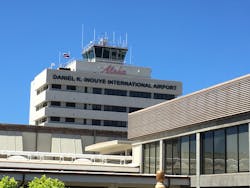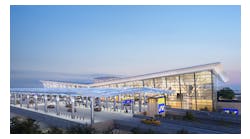The Hawaii Department of Transportation (HDOT) Airports Division rolled out free unlimited Wi-Fi throughout the Daniel K. Inouye International Airport (HNL) in June.
Operated by Boingo Wireless, the project was initially launched in December, with a gradual rollout through the airport. The project entailed adding a Distributed Antenna System (DAS) to improve cellular connectivity by boosting strength for cellphone users.
“What we wanted for the airport was free Wi-Fi,” Ross Higashi, deputy director of airports for HDOT said. “Especially for the international travelers, they ask for Wi-Fi and that’s a big addition to the customer experience here.”
The push for free Wi-Fi at Hawaii’s airports didn’t start with customers, but from the state legislature. Higashi said lawmakers determined the state’s commercial airports needed Wi-Fi and directed him to come up with a solution.
Hawaii doesn’t have an airport authority overlooking the facilities, so changes are dictated by the state.
“Every other airport has free Wi-Fi today,” he said. “It wasn’t mandated, it was just that they were pushing it and they would call us and say that we need to get free Wi-Fi.”
HDOT is rolling out the Wi-Fi and DAS systems across all of Hawaii’s commercial service airports by the end of the year. Kahului Airport (OGG), Hilo International Airport (ITO), Ellison Onizuka Kona International Airport at Keahole (KOA) and Lihue Airport (LIH) all lacked Wi-Fi service prior to the project.
Higashi said HDOT started with HNL for free Wi-Fi because it has 10 million enplanements per year and has been the traditional hub of commercial air service in the state. However, airline patterns have shifted in recent years and more are traveling direct to the other airports, meaning the service is important there as well.
“Everybody is kind of like a hub now, except Hilo,” he said. "[Honolulu] is still the hub, but it’s not the only hub.”
The Wi-Fi was set up with a DAS system to create a more powerful network across the airports.
“Everybody no matter who your carrier is will have a stronger signal strength with your cellphone coverage,” Higashi said.
HNL switched from its previous Wi-Fi provider to Boingo in December. Higashi said the system is stronger and is free for users, which was a key aspect leaders were looking for.
Users of the Wi-Fi watch a 30 second commercial and then have access to the Internet, which is provided at 5 Mbps speed. Passengers looking for a stronger system can pay for 10 Mbps.
Danielle Aiello, vice president of account management for Boingo, said construction began on the Boingo Wi-Fi project at HNL in July 2017. It was completed in time to do a limited rollout of the network prior to the holiday season.
“They absolutely wanted fast, free Wi-Fi throughout all public space,” she said.
Both of the installation teams also needed to coordinate with ongoing construction teams at HNL to make sure passengers were able to move around the terminal uninterrupted. They coordinated with HNL to ensure efficiency and to make sure movements were not interrupted during peak traveler times.
“We were constructing a Wi-Fi network and a DAS network so it was really important to be aligned between our DAS project team and the carrier teams and the Wi-Fi team,” she said. “We’re typically not installing Wi-Fi and a DAS at the same time.”
Wi-Fi and cellular working in tandem is called network convergence, which provides more throughput, reduced latency, better coverage and lower costs. Network convergence helps the wireless platform lay the necessary foundation for airports to answer the demand for more mobile data and wireless connectivity. Aiello said this will be especially important for 5G.
Aiello said the DAS deployment was carrier-ready in April. It took longer because the team needed to work with each carrier on specific designs.
“It’s a partnership with HDOT. The communication cadence was tightened,” she said. “We wanted to make sure that at the state level and at the local airport level that all stakeholders, whether they’re a deputy director or an IT manager, were fully exposed. There was transparency with how we were doing, if we were on schedule and if we needed to escalate anything to help push things through.”
Higashi said Boingo invested more than $1 million into the Wi-Fi infrastructure. The airport didn’t pay anything and will be provided monthly revenue as part of the agreement.
“They’re basically a concession,” he said.
Aiello said more than 70 percent of the network was deployed prior to the holiday season, which included the central and main terminals.
“That challenge was really making sure we were collaborating with our partner and delivering the right experience for that airport and for those travelers based on their needs,” Aiello said.
Aiello said Boingo continues to track ongoing customer sentiment and contact with the airport and customer experience.
“We have our finger on the pulse of the customer experience,” she said.
Work at the other four commercial airports in Hawaii is underway. Aiello said there are local teams working on site with each of the airports to deploy the system like at HNL.
Concession boost traveler experiences
Free Wi-Fi is part of a larger effort by Hawaii to upgrade the overall passenger experience when using the airports. HDOT started a quasi-public-private partnership with its concessionaires in 2016, which created $30 million in upgrades to the Central Concourse and $39 million in tenant improvements.
Anthony Alessi, vice president of business development for HMSHost, said they were tasked creating a better passenger experience with an emphasis on building a local Hawaiian experience inside the terminal. Part of the improvements included enclosing the shopping area of the terminal. It had previously been open air, so travelers were subject to the elements.
“There’s a lot of expertise brought to the table and creativity and lessons learned from other environments applied to here and how to make it better,” he said. “While there were those unique challenges of an older building and how do you not tear it down, but rethink about how it’s used, it allowed us to collectively come together and overcome those challenges.”
DFS and HMSHost updated respite gardens within the airport passengers can utilize. Under the agreement, the concessioner built and maintained the gardens for one year, then turned them over to the airport. The areas have real plants and even a large koi pond, modeled after Chinese and Japanese cultural gardens.
“We provide a space where people can spend their last minutes or their last hours in Hawaii enjoying it,” Higashi said. “Not a lot of large hub airports have that.”
Open air walkways within the terminal face out to the gardens allowing travelers a full view of the facilities, which they can also access prior to their flight. The additional space also allowed the airport a space to display local art to passengers.
Higashi said the $70 million invested into the airport helped build out a 30-foot cantilever facing the gardens so more stores could be added to the interior facing part of the terminal.
The airport also worked with the concessionaire to build an air conditioned security checkpoint.
“We extended their agreements by seven to 10 years and in turn they’ve invested in our airport,” Higashi said. “About $30 million was for the cantilever, the checkpoint and the revitalized gardens. The other $40 million they put into renovating their shops as well to generate more revenue.”
Part of the terminal is set up to look like Waikiki, with higher end retail shops, which are favorites of international travelers.
“For a lot of the Asian travelers, their tradition is to take something back,” Higashi said. “This is their last opportunity to take something back if they didn’t get it already.”
Alessi said HMSHost’s goal was focused on bringing in authentic local food and working with community partners to create a Hawaiian experience within the terminal.
“We really wanted to focus that with the governor’s goals of creating more of an authentic Hawaiian experience,” he said. “Our focus was on delivering that, investing in locally sourced products, local flavors and concepts tied to those.”
Live musicians are also present to give incoming travelers their first taste of Hawaiian culture.
“Sometimes we even have hula dancers out here,” Higashi said.
HDOT also signed a recent agreement with Clear Channel to provide advertising space in the terminal as well.
“For the longest time we didn’t want advertising. We wanted to keep it simple, we wanted to keep it a place of relaxation without all the hustle and bustle of what’s going on,” Higashi said. “As times have changed, attitudes have morphed and we’re trying to place it in tastefully.”
Higashi said HNL is in the processes of modernizing all of its signage as well. The airport is building a new concourse, so all of the numbering for gates needs to be redone.
Green commitment grows
Higashi said HNL is continuing its commitment to energy savings projects at the airport. About $200 million was invested in energy saving equipment, such as photovoltaic systems on the roofs of the terminals, a conversion to LED lighting inside the terminal; and a new air conditioner system.
“By investing $200 million we will save approximately $518 million over the next 20 years,” he said. “It’s a tremendous cost benefit.”
Higashi said he’s always focused on financials, so the green initiatives are very positive for him to act on.
“I could’ve waited another four years and probably gotten a better price for photovoltaic panels, but at the same time, I just lost four years of savings,” he said.
HNL has an initiative to be 100 percent sustainable by 2045, so it’s continuing to explore projects like reclaiming water and different sources of energy to fuel rental car buses.
Higashi said the airport is testing hydrogen fuel, compressed natural gas and electrified buses to see which proves to be the most reliable and efficient.
In July, the airport announced it was installing 4,200 solar modules on its Terminal 1 parking garage.
HNL: Getting A380 ready
All Nippon Airways approached the airport a couple of years ago about the potential of handling an A380 aircraft, which carries about 520 passengers, compared to the current Boeing 787s, which carry about 250 passengers.
HNL is preparing the terminal for the A380 and putting an additional space for a boarding bridge at the expected gate so it can be double loaded.
ANA is also installing a business executive lounge at the airport.
Eventually there will be three A380s coming into HNL per day within the next couple of years. Higashi said the economic impact of the additional passengers is more than $300 million annually.
“We’ll have two gates for A380s,” Higashi said. “The first flight comes in March or April of 2019.
"At some point in the next two years we will have three A380s coming into Hawaii, which is big for us.”




![Logo Notag Hex[1]x100 Logo Notag Hex[1]x100](https://img.aviationpros.com/files/base/cygnus/cavc/image/2020/10/logo_notag_hex_1_x100.5f9c63c6d8cae.png?auto=format,compress&fit=fill&pad=5&fill-color=white&q=45&h=139&height=139&w=250&width=250)

